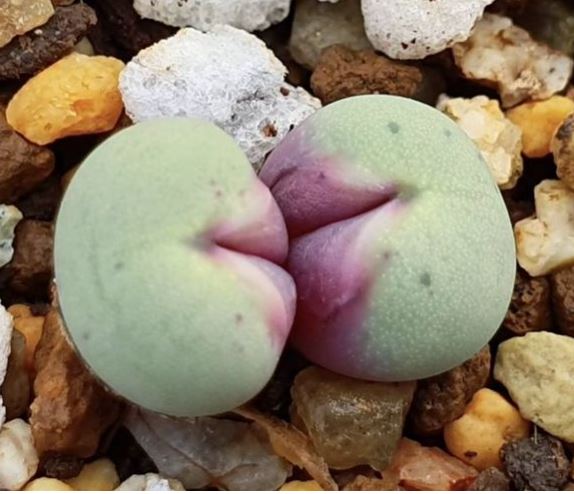Conophytum pageae is a unique succulent plant native to the Namib Desert in Namibia. This plant, which is also known as the “lip plant,” has a distinctive appearance that resembles a pair of lips. Its striking shape and vibrant colors make it a popular choice for collectors and gardeners around the world.

The name Conophytum pageae is derived from the Greek words “cono,” meaning cone-shaped, and “phytum,” meaning plant. The species was named in honor of Olive Mary Page, a British botanist who specialized in the study of succulent plants.

The lip plant is a small, compact plant that grows in clusters. Each individual plant consists of two fleshy, cone-shaped leaves that are fused together at the base. The leaves are covered in small, warty bumps that give them a rough texture. The plant’s leaves are green in color, but they can also range from pink to purple depending on the amount of sunlight they receive.
In the spring and summer months, the lip plant produces s  mall, daisy-like flowers that are yellow or white in color. These flowers are held on thin, wiry stems that rise above the plant’s leaves. The flowers are pollinated by bees and other insects, which are attracted to their sweet nectar.
mall, daisy-like flowers that are yellow or white in color. These flowers are held on thin, wiry stems that rise above the plant’s leaves. The flowers are pollinated by bees and other insects, which are attracted to their sweet nectar.
The lip plant is a highly adaptable species that can survive in harsh desert conditions. It has a shallow root system that allows it to absorb moisture from the surrounding soil. The plant is also able to store water in its leaves, which allows it to survive long periods of drought.
The lip plant is often grown as a houseplant or in outdoor rock gardens. It is a low-maintenance plant that requires little water and can thrive in a variety of soil types. When grown indoors, the plant should be placed in a bright, sunny location and watered sparingly.
One of the most unique features of the lip plant is its ability to change color in response to environmental conditions. When the plant is exposed to bright sunlight, its leaves will turn a deep purple color. In contrast, when the plant is grown in shade, its leaves will remain green. This color change is thought to be an adaptation that helps the plant regulate its internal temperature in the hot, dry desert environment.

The lip plant is a popular choice for collectors and enthusiasts of succulent plants. It is a highly sought-after species due to its unique shape and vibrant colors. However, due to its small size and slow growth rate, the lip plant can be difficult to propagate and may be expensive to purchase.
In recent years, the lip plant has become increasingly threatened in its natural habitat due to habitat loss and over-collection. As a result, it is now listed as a vulnerable species by the International Union for Conservation of Nature (IUCN). Conservation efforts are underway to protect the plant’s habitat and ensure its survival for future generations.
In conclusion, Conophytum pageae, also known as the lip plant, is a unique and fascinating species of succulent plant. Its distinctive shape and vibrant colors make it a popular choice for collectors and enthusiasts of succulent plants. However, due to its vulnerable status in the wild, it is important to take steps to protect and preserve this remarkable species for future generations to enjoy.